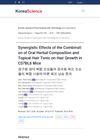TLDR Women generally want more hair volume, which becomes a concern around menopause due to hair loss.
In the study by Robbins et al., involving 1414 adult women, it was found that hair density decreases with age, but until the age of 40, this loss is compensated by an increase in hair fiber diameter. This compensation may be why women often seek treatment for hair loss around menopause. The study highlights the challenges in treating hair loss, including the lack of highly effective treatments and the need for accurate tools to measure treatment response. Current treatments for female pattern hair loss can result in a 10-20% improvement over 6-12 months. The most important outcome for patients is visible hair volume, which is difficult to standardize in measurements due to factors like hair greying and styling. The study also introduces a new measure of hair amount that considers both hair density and fiber diameter, which may improve the assessment of treatment response in the future.
 61 citations
,
April 2012 in “British Journal of Dermatology”
61 citations
,
April 2012 in “British Journal of Dermatology” Caucasian women's hair appears thickest in their 20s, with perceived thinning after mid-30s due to both decreasing density and diameter.
 193 citations
,
August 2005 in “Journal of Investigative Dermatology Symposium Proceedings”
193 citations
,
August 2005 in “Journal of Investigative Dermatology Symposium Proceedings” Hair loss common in Australia; men affected earlier, more often than Asians; women less concerned.
 179 citations
,
March 2005 in “British Journal of Dermatology”
179 citations
,
March 2005 in “British Journal of Dermatology” Oral antiandrogens effectively treat female hair loss, with better results in higher hair loss grades.
 1 citations
,
September 2022 in “Journal of The American Academy of Dermatology”
1 citations
,
September 2022 in “Journal of The American Academy of Dermatology” Baricitinib helps grow eyebrows and eyelashes in severe alopecia areata patients.
 April 2018 in “Journal of Investigative Dermatology”
April 2018 in “Journal of Investigative Dermatology” Topical tofacitinib is effective in promoting hair growth for non-scarring alopecia.
 1 citations
,
April 2012 in “Korean Journal of Food Science and Technology”
1 citations
,
April 2012 in “Korean Journal of Food Science and Technology” Using both oral herbal supplements and hair tonic together works better for hair growth than using just the tonic.
January 2012 in “프로그램북(구 초록집)” May 2011 in “Harper's Textbook of Pediatric Dermatology” Alopecia areata causes patchy hair loss and has no cure, but treatments like corticosteroids and minoxidil can help.
 2 citations
,
February 2009 in “Journal of Evidence-Based Medicine”
2 citations
,
February 2009 in “Journal of Evidence-Based Medicine” No treatment showed significant long-term hair growth benefits for alopecia areata.








